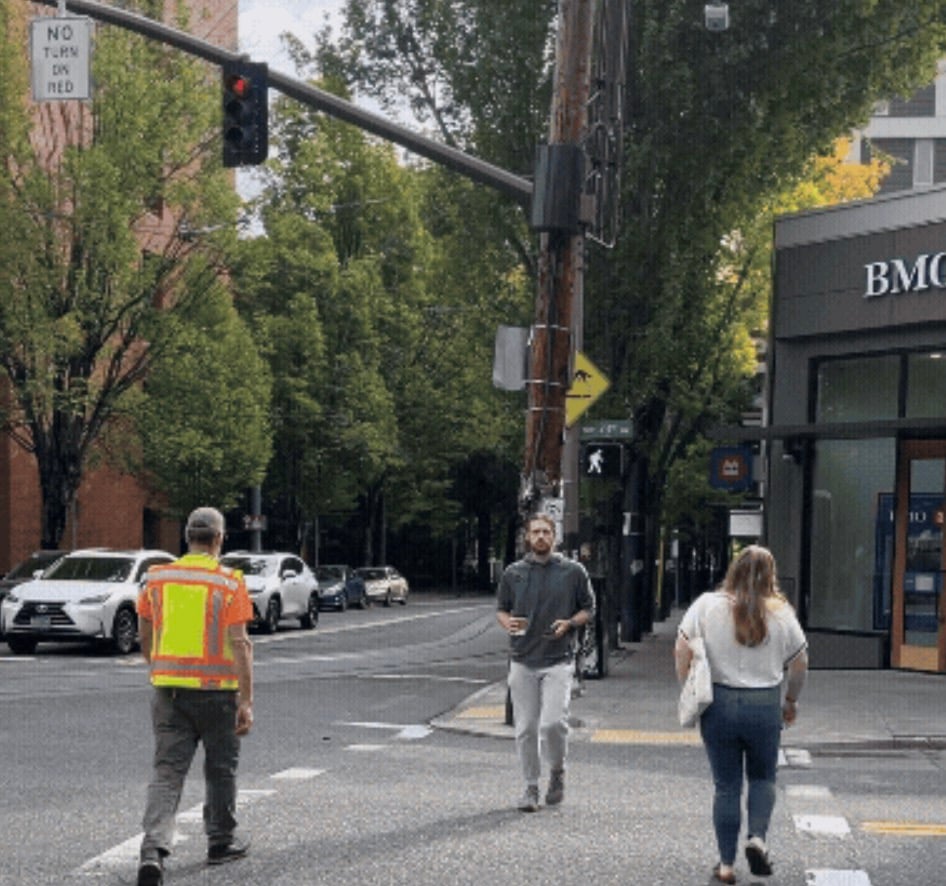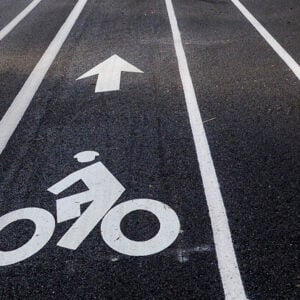Here’s an example of putting a higher price on car use can benefit an entire community.
One of the ways the Portland Bureau of Transportation manages curbside parking in areas with high demand for spaces is to form parking districts. PBOT then works with neighborhood residents (via volunteer committees) to invest the resulting parking meter and permit revenue back into street upgrades.
Over the past year, PBOT worked with the Northwest Parking District Stakeholder Advisory Committee on a project to make walking safer. With input from PBOT’s Vision Zero team and recommendations from the Northwest in Motion Plan, they came up with a list of 15 intersections where the installation of a “no turn on red” policy and/or a “pedestrian head start” (a.k.a. leading pedestrian interval or LPI) could make a positive impact on safety for non-drivers.
In an update from PBOT shared today, they’ve completed these upgrades using funding approved by the committee. In addition to signage aimed at preventing right turns on red and signal changes to give walkers a head start through intersections, PBOT also added accessible push buttons at some of the intersections for folks who are blind or have low-vision.
For the uninitiated, pedestrian head starts give walkers a green signal several seconds before drivers. This gives walkers a chance to get through the intersection and it makes them easier to see by right-turning drivers. Think of these signals as bike boxes for walkers. PBOT cites studies that show pedestrian head start treatments can reduce pedestrian-vehicle collisions as much as 60%.
A July 2024 PBOT memo about the project said all 15 intersections could be upgraded for just over $140,000 — which shows just how affordable these upgrades are. (Note I’m not sure if the recently completed work took care of the full 2024 proposal. I will update this post once I clarify.)
According to that memo, PBOT created new “no turn on red” restrictions at 15 intersections, pedestrian head starts at 11 intersections, and new accessible push buttons at five intersections in the Northwest Parking District.
The intersections included: NW Everett at 18th, 19th, 21st, and 23rd avenues; NW Glisan at 18th, 19th, 21st, and 23rd; NW Lovejoy at 18th, 19th, 21st, and 23rd; NW Northrup at 23rd; NW Raleigh at 23rd, and NW Thurman at 23rd.






Thanks for reading.
BikePortland has served this community with independent community journalism since 2005. We rely on subscriptions from readers like you to survive. Your financial support is vital in keeping this valuable resource alive and well.
Please subscribe today to strengthen and expand our work.
The people that are going to follow these sign directions were never the problem. So you create a slowdown for already safe drivers and a nothing burger for the unconcerned motorist. Will they shake their heads and talk about how clear the signage was when it (very often) becomes even more dangerous at these type of intersections because of all the random rule breaking that occurs?
Lmao this is the most boomer take I’ve read this month
I don’t agree with the OP, but please refrain from the ad hominem ageism. It’s fallacious and mean.
Hi Bud,
I ride, walk, and drive intersections with no turn on red and leading pedestrian intervals throughout Portland all the time. People generally do follow the rules, and I always feel safer when I’m walking or biking through them. Being several yards out into the intersection when cars start to go is a much more visible spot to be.
Your argument seems to say that we shouldn’t try and make any improvements anywhere at any time, because some people might break the rules. I really think that a better and safer city is possible by making changes to our built environment and traffic rules. Even if those changes have to be small and incremental for now, let’s take them and build on them.
Finally, there is no such thing as a safe driver. There is only safe driving. People following these new rules (again, my experience is that it is the vast majority of people) will be driving more safely, which also almost always means driving more slowly.
For the underlined part: this isn’t always true. In congested areas, it only takes the lead driver to comply with a rule like this (no turn on read, but also lower speed limits) and the vehicles behind them follow suit.
I live on Holgate. Traffic very often travel well above the 25 mph speed limit *and* it only takes a couple of people intentionally going 25 mph to dramatically change the overall speeds.
And i wonder if you look in the driving people of those habitual speeders, if you could find reason for escalating fines and/or suspension. But living and driving in Portland means one does not receive citations.
I also get a bit frustrated when I’m driving and I see a “no turn on red” type intersection that slows me down, as I know I am a safe, alert driver.
But I take a step back and consider that these changes are made for a reason (usually written in blood). Instead of blaming the people getting maimed by cars or the City, I blame the drivers who came before, and created the unsafe environment. It’s unfortunate that we can’t guarantee safer behavior from everyone.
I’m interested to here more details and data on your assertion that these intersections are somehow more dangerous after the change, because that has not been my experience.
An intersection I walk across often got changed a couple years ago to no turn on red with a pedestrian head start. At first, lots of drivers turned on red. Now not many do. And ones who may want to turn on red can’t if they’re behind a compliant driver. It’s a great safety improvement.
I used to regularly have drivers turn left right into me as I crossed when the light turned green. Now I’m out of their path before they get a green.
I like them when driving. They reduce the times drivers behind honk or get impatient for me to turn when they can’t see that it’s not safe for me to turn, or think I’m being too cautious.
A huge benefit is they also decrease by a lot the number of drivers who pull across and block the crosswalk so they can see to the left so they can turn right on red. Crazily, some STILL do that, but not many.
Has anyone looked into bikes using the pedestrian head start? Using it feels safer, and better for (bike and car) flow.
I do at intersections where it makes sense. Places like Lincoln/Clinton and Ceasar Chavez where bike scan get out of the way before the car light turns green, of SE 34th and Division where left-turning cars don’t have to wait for me. I think the law should be amended so that cyclists in the lane closest to the crosswalk are allowed to go on the pedestrian signal.
Bikes can legally use crosswalks. The City also uses a leading interval for bike signals in some places, like SW Salmon as you approach Naito.
I think both of those facts would give weight to the argument that the law should be changed to make it clear that bicycle riders — even if they are not in the crosswalk — can use the crosswalk signal when a bike signal is not present. Heck, come to think of it, are LPIs even called out specifically in Oregon Statute yet?
Slow, steady progress. It’s not exciting, but it can save lives, and I’m all for it.
LPIs are also important bike infrastructure whatever “the law” says.
Yes I agree with Soren. I will often use LPIs because it makes sense and eventually we will get the law to allow bikes to use them.
But Scott, to answer your question: I am not aware of anyone working on legislation to make that change official. I’m pretty sure NYC did and I am sure that if someone in Oregon wanted to do the work, we could get it passed at the legislature.
I genuinely thought bikes were already supposed to ride with the pedestrian signal. I agree with Scott that it feels a lot safer and better for flow. I also think it’s more predictable.
I now see PBOT’s website says that bikes have to remain stopped for a steady red traffic signal. I’m surprised. It’s been a number of years, but maybe I’m thinking back to when I lived in DC and saw signs everywhere that said “bikes use pedestrian signals.” I understand transportation advocates have a lot on their plates right now, but this feels like a relatively easy, common sense fix.
I think you’re basing this statement off of this bullet point from the link you provided:
But in this context of the Idaho Stop (which we adopted a few years ago), I don’t think that key words in your sentence (“have to remain”) are implied.
If the light is red, stop. If the coast is clear, proceed with caution.
I think that’s a completely different thing than both the Idaho stop (only applies to stop signs) and LPI (where you still have to wait for the walk sign).
Still perfectly fine and not objectionable, just saying.
Oregon (as nubaloo pointed out to me), only adopted half of the Idaho Stop — signs as yields. In some states, you can treat red lights as stop signs and proceed when the coast is clear.
If Oregon had adopted that aspect of the Idaho Stop like I thought, then the LPI would be a time when you could expect the coast to be clear.
though “Idaho stop” refers to both bikes treating stop signs as yield *and in some places* treating red lights as stop signs, only four states allow the latter. Oregon only allows stop as yield, not red light as stop – we really should get on changing that!
https://en.m.wikipedia.org/wiki/Idaho_stop
Ahh — thanks for the info. I though Oregon had gone full Idaho (stop)
I’m surprised and kind of think this is a contradiction in the law, because bikes are also legally allowed to use the crosswalk, without getting off the bike. I also don’t believe that the crosswalk is defined as “only the parts the paint touches”, so I don’t see how, way over on the right side of the road, that isn’t basically just using the crosswalk. If one was really concerned, I think you could just scoot over into the crosswalk as you cross and even be following the letter of the law.
But I dunno, I’m not a lawyer, but I’m going to do it anyway because it’s the right thing to do.
I love LPIs and think they should be the absolute default.
LPIs and banning turns on red were top recommended mitigations from Portland’s decade old vision zero process. Maybe we will fund this adequately after the next task-force meets for 5 years…
I agree that LPIs should be default and also that a pedestrian crossing signal should be a default. Why are we even still installing beg buttons in the Pearl and places like that? Wouldn’t it be cheaper to just make the ped xing signal default than to add additional “accessible” beg buttons? In my experience beg buttons are hardly ever accessible even for people with average mobility.
This is fantastic!
Hopefully people are familiar with the concept of a Parking Benefit District, where parking is priced (ideally at market rate) and a good chunk of the revenue is returned to the district for locally preferred projects. The Northwest District is one of the most interesting PBDs in the country at the moment, and this project is SUCH a great example of the upside of PBDs. Great catch here, Jonathan!
I’ve been saying for a while that Portland should look at implementing PBDs wherever there is paid parking, and my first thought in reading your coverage of the Sheridan Street proposal was, “oooh, that’s exactly the sort of thing that a PBD could fund!” It’s harder to do when you already have metered parking as those revenues are already spoken for, but this is a good example of the potential.
Just wait till an obscure city ‘safety’ office learns about these no-turn-on-red restrictions and how they delay police response to crimes-in-progress!